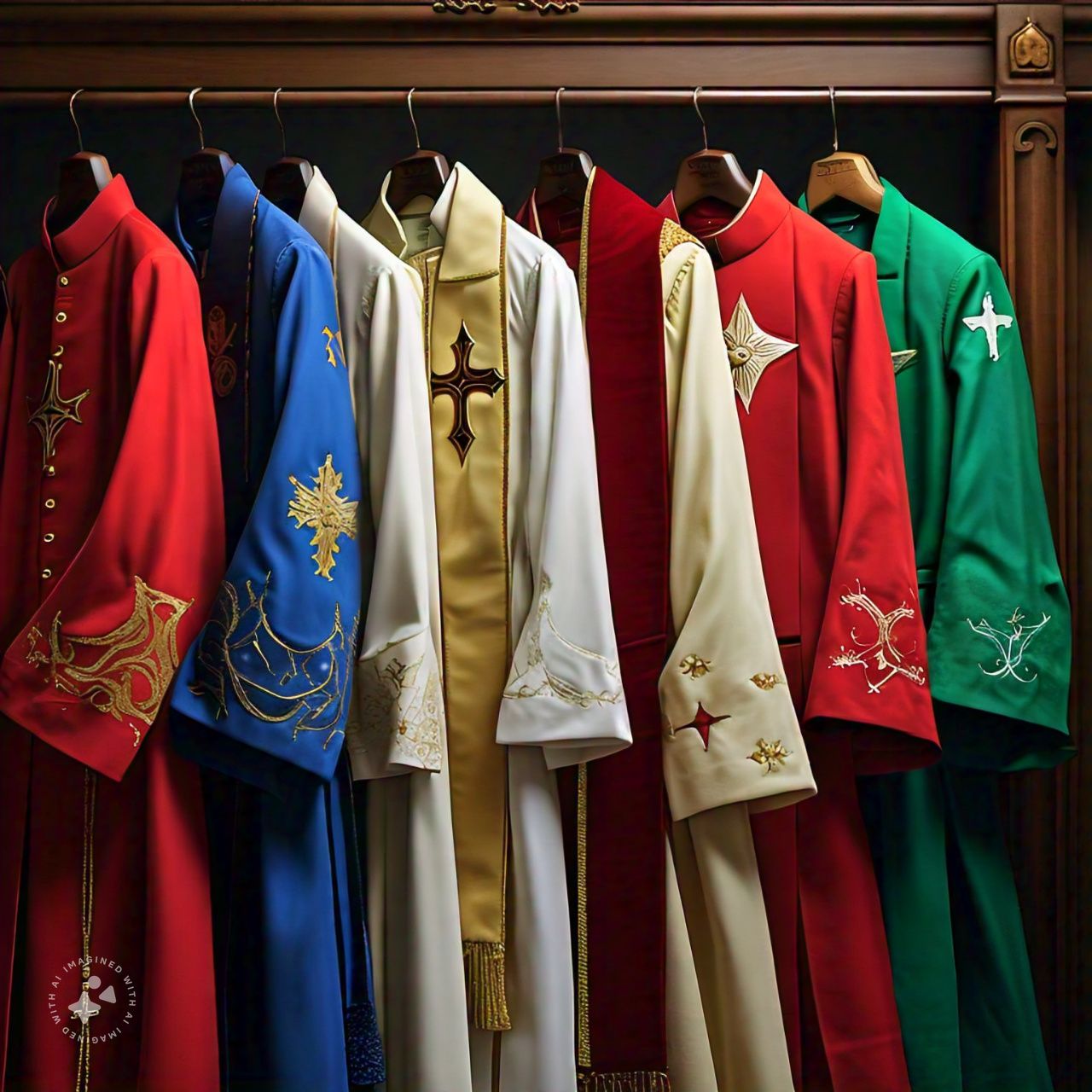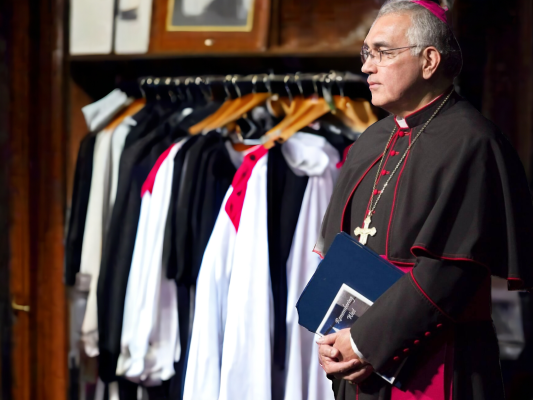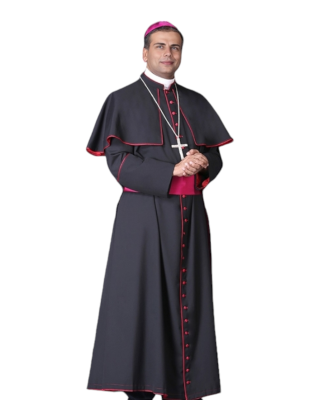No products in the cart.
Return To Shop
How Do You Clean and Care for Bishop’s Cassock?
Care for Bishop’s Cassock; A bishop’s cassock is a garment rich in symbolism, tradition, and respect. As a key element of bishop attire, it’s not only worn during formal church services but also serves as a representation of the bishop’s spiritual role and authority. Therefore, it’s crucial to maintain this sacred garment with the utmost care, ensuring that it remains in pristine condition for years to come.
We will explore the best practices for caring for and cleaning a bishop cassock. We’ll cover everything from fabric maintenance and proper cleaning methods to storage tips, and offer some new insights into prolonging the life of your bishop attire. Whether you’re responsible for the upkeep of a cassock or seeking to learn more about this revered piece of clothing, this guide will provide valuable information.
Understanding the Significance of the Bishop’s Cassock
Before diving into care instructions, it’s essential to understand the significance of the bishop cassock. The cassock is an ecclesiastical garment worn by bishops during liturgical ceremonies, processions, and other religious events. In the Roman Catholic tradition, the bishop’s cassock is typically black with red piping, buttons, and a red fascia (sash) around the waist. In other Christian denominations, such as Anglicanism, the cassock may be purple or red, often symbolizing the bishop’s authority.
The cassock is both a practical and symbolic part of bishop attire, representing the bishop’s office and devotion to the church. It is a garment that must be treated with care, respect, and reverence.
Fabric Types and Their Care for Bishop’s Cassock Requirements
The first step to properly caring for a bishop cassock is to understand the fabric it’s made from. Bishop attire is typically crafted from fine, durable fabrics like wool, polyester, or a blend of these materials. Each fabric type has its own set of care instructions that should be followed to preserve its appearance and longevity.
Wool Cassocks
Wool is one of the most traditional fabrics used in bishop cassocks. It offers warmth and a rich texture, making it ideal for ceremonial occasions. However, wool requires special care to avoid shrinkage or damage. Here’s how to care for wool cassocks:
- Dry Cleaning Only: Wool bishop cassocks should never be machine washed or hand washed, as the fabric is sensitive to water and agitation. Always opt for professional dry cleaning to maintain the integrity of the wool.
- Storage: Wool is susceptible to moth damage, so it’s important to store the cassock in a well-ventilated garment bag made of natural fibers. Mothballs or cedar blocks can also be placed near the cassock to deter pests.
- Steaming: If wrinkles form, use a handheld steamer instead of an iron. Direct heat from an iron can damage the wool fibers, while gentle steaming will help remove wrinkles without causing harm.
Proper cleaning of a bishop cassock requires careful attention to detail. Whether you’re dealing with a minor stain or refreshing the entire garment, following these steps will help ensure the cassock remains in top condition.
Spot Cleaning for Minor Stains
Minor stains, such as those caused by food or drink spills, should be addressed immediately to prevent permanent damage.
- Blot the Stain: Use a clean cloth or paper towel to blot the stain. Do not rub the fabric, as this can push the stain deeper into the fibers.
- Use a Mild Cleaner: For most fabrics, a mild detergent mixed with water can be used to treat the stain. Dampen a clean cloth with the solution and gently dab the stained area.
- Rinse with Cold Water: Once the stain has been treated, rinse the area with cold water and blot dry. Avoid soaking the fabric or using hot water, as this can set the stain.
- Dry Cleaning for Wool: If the cassock is made of wool, avoid water-based cleaning methods and take the garment to a professional dry cleaner as soon as possible.
Full Cleaning for Tropical Fabric Cassock | Care for Bishop’s Cassock
Tropical fabric cassocks are designed to be lightweight and breathable, making them ideal for use in warmer climates. However, they require specific care to maintain their appearance and longevity. Here’s a step-by-step guide for cleaning a tropical fabric cassock:
Pre-Treat Stains
Before starting the full cleaning process, inspect the cassock for any visible stains.
- Spot Treat: Use a gentle, non-bleach stain remover or a mixture of mild detergent and water. Dab the stain with a clean cloth, ensuring not to rub it in deeper.
- Test First: Always test the stain remover on an inconspicuous area of the cassock to ensure it does not damage or discolor the fabric.
Hand Washing
Tropical fabric cassocks should generally be hand-washed to maintain the delicate nature of the material.
- Fill Basin: Fill a basin with lukewarm water and add a mild detergent suitable for delicate fabrics.
- Submerge and Soak: Submerge the cassock in the soapy water and gently swirl it around. Allow it to soak for 10-15 minutes to lift dirt and oils from the fabric.
- Gently Agitate: After soaking, gently agitate the cassock in the water by moving it back and forth. Avoid scrubbing or wringing the fabric, as this can cause damage or distort its shape.
Rinse Thoroughly
After washing, it’s crucial to remove all soap residue.
- Rinse in Clean Water: Drain the soapy water and refill the basin with clean, lukewarm water. Submerge the cassock and gently agitate to rinse out the detergent.
- Repeat: You may need to rinse a second time to ensure all soap has been removed. Any soap left behind can cause the fabric to stiffen.
Drying
Proper drying is essential to maintain the tropical fabric’s integrity and prevent shrinkage.
- Press to Remove Water: Gently press the cassock between towels to absorb excess water. Avoid twisting or wringing the fabric.
- Air Dry: Hang the cassock on a padded hanger in a well-ventilated area, away from direct sunlight. Air drying is best for tropical fabrics to prevent shrinkage and maintain the garment’s shape.
- Avoid Dryers: Do not use a tumble dryer, as the heat can damage the fibers of the tropical fabric.
Steaming or Ironing
Tropical fabrics can wrinkle, so they may require gentle steaming or ironing.
- Steaming: Use a handheld steamer to remove wrinkles without damaging the fabric. Hold the steamer at a distance to avoid direct contact with the cassock.
- Ironing: If ironing is necessary, use a low heat setting and place a pressing cloth between the iron and the fabric to prevent scorching or shining. Always iron on the reverse side of the fabric.
Storage
Proper storage after cleaning is key to preserving the tropical fabric cassock.
- Hang in a Garment Bag: Store the cassock on a padded hanger in a breathable garment bag to protect it from dust, moisture, and insects.
- Avoid Folding: Avoid folding the cassock for long-term storage, as this can create creases in the fabric. If folding is necessary, use acid-free tissue paper between the folds to reduce wrinkles.
By following these steps, you can ensure that your tropical fabric cassock remains clean, fresh, and ready for use, even in warm climates. Proper care will extend the life of the cassock and keep it looking pristine for every occasion.
Conclusion
Caring for and cleaning a bishop cassock is a responsibility that ensures this important garment remains in excellent condition, ready to serve its purpose during religious ceremonies. Whether the cassock is made of wool, polyester, or a blend of fabrics, proper cleaning, maintenance, and storage are essential for preserving its beauty and functionality.
For those looking for high-quality bishop attire, including cassocks, robes, and accessories, Clergy Wear Shop offers a wide range of products designed with durability, elegance, and comfort in mind. Whether you need custom garments or ready-made options, Clergy Wear Shop provides attire that meets the needs of modern bishops while honoring the traditions of the church.
Frequently Asked Questions (FAQs)
How often should a bishop cassock be dry cleaned?
It depends on how frequently the cassock is worn, but generally, a wool cassock should be dry cleaned every few months or after significant religious events. Polyester cassocks may require less frequent cleaning.
Can I machine wash a bishop cassock?
Polyester cassocks can often be machine washed on a gentle cycle, but wool cassocks should always be taken to a professional dry cleaner.
What should I do if my cassock becomes stained during a service?
Immediately blot the stain with a clean cloth and treat it as soon as possible. For wool cassocks, take the garment to a dry cleaner promptly.
How do I store my cassock when it’s not in use?
Store the cassock in a breathable garment bag in a cool, dark place. Ensure the garment has enough space to hang freely without becoming creased or squished.
Where can I buy high-quality bishop attire?
You can find high-quality bishop attire, including cassocks and robes, at Clergy Wear Shop, an online store specializing in clergy garments and accessories.















Add comment
You must be logged in to post a comment.